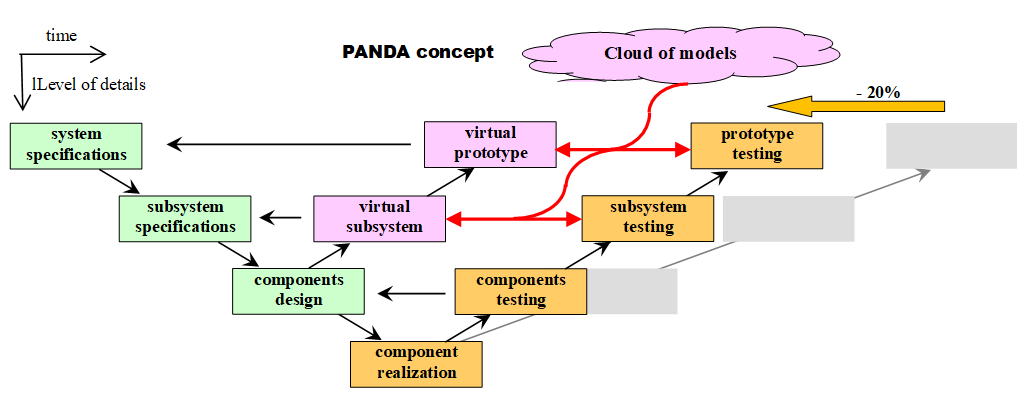PANDA will enable the automotive industry to drastically speed up the design and testing of EVs, and the ambition of PANDA is to reduce the time-to-market of EVs by 20%. Traditionally, industrial products are generally developed according to the V-model. On the left side in green, the overall system specifications (e.g. driving range of an EV) are broken down into subsystem specifications (e.g. battery capacity) and finally into component design (e.g. a design for a battery). Once the components are built, on the right side in orange everything is tested and integrated, from component level (e.g. a physical battery) to finally a working prototype (a working EV). The advantage of the V-process is the consistent feedback between design (left side) and validation (right side), which leads to fewer real prototypes. However, the V-model is still a time-consuming process.

PANDA will make the development process faster by adding a virtual validation axis and re-arranging the V-model to a W-model. In below figure this axis is shown in pink. Whilst simulations are already used to reduce the number of physical tests, the high accuracy that is needed at the system level currently ask a lot of computational effort. That makes existing simulations too slow for realtime models. In PANDA multi-scale and multi-domain simulation packages are developed to interconnect all components of electrified vehicles. The end result will be that virtual components can be as easily connected and tested as components in real life.

The basis of the PANDA innovation is the Energetic Macroscopic Representation (EMR) formalism. EMR is a method to organise models of energetic systems (such as electrified vehicles, batteries and other electrical components). Rather than using structural models to represent components (e.g. modeling a battery using virtual electrodes and electrolyte), EMR uses the power flow to represent components. For example, in EMR a battery can be connected to an electric motor by just coupling the voltages and currents (i.e. properties related to the power). Below figure shows this schematically.
Initiated in 2000 by L2EP of ULille, EMR is now taught worldwide and used in industry (e.g. Alstom transport, PSA Peugeot Citroën, Valeo, Siemens Mobility, SNCF). See http://www.emrwebsite.org/ for more details. In PANDA new rules will be defined specifically to interconnect structural models in such a functional framework. Also, advanced algorithms are required to solve connecting issues, such as conflicts of association.
